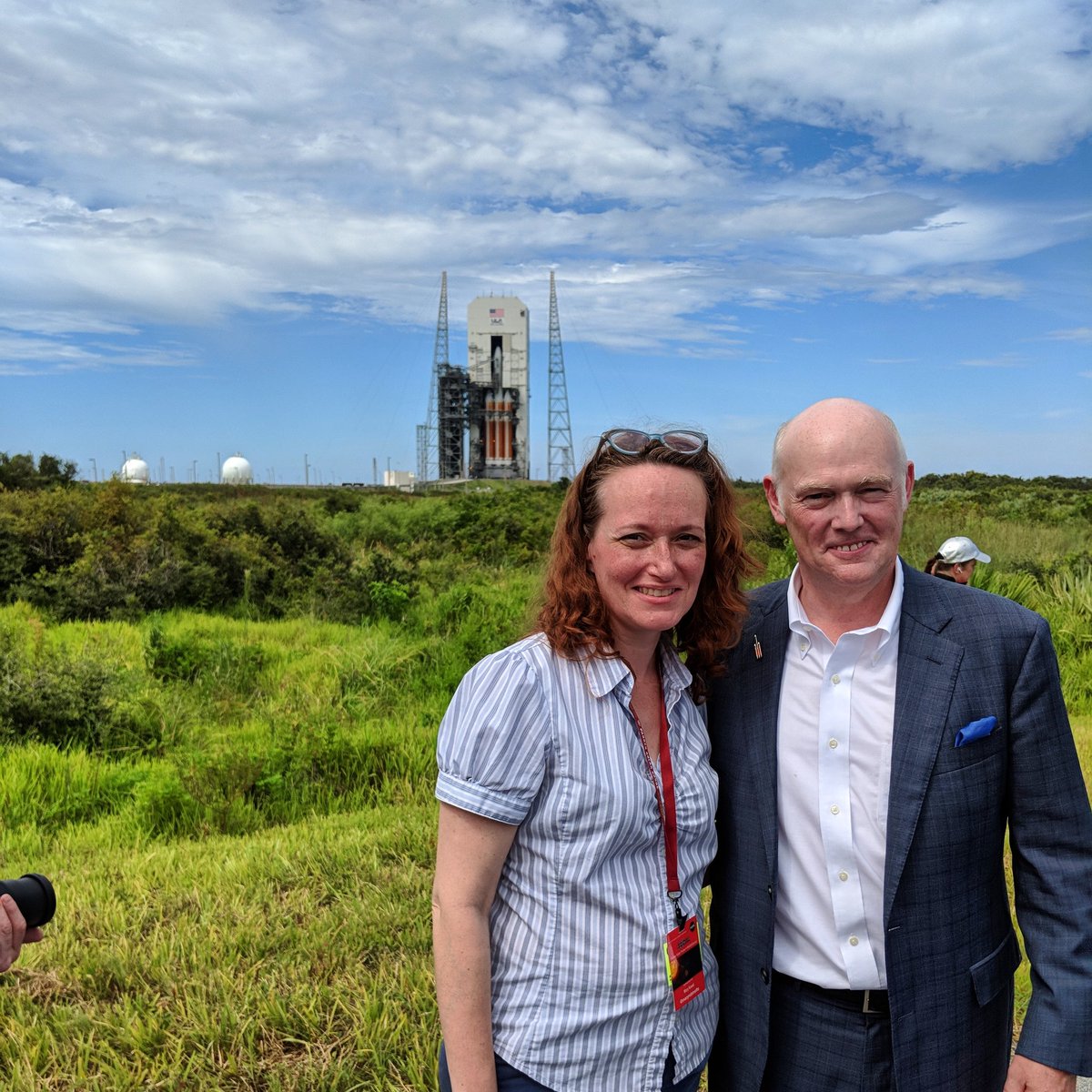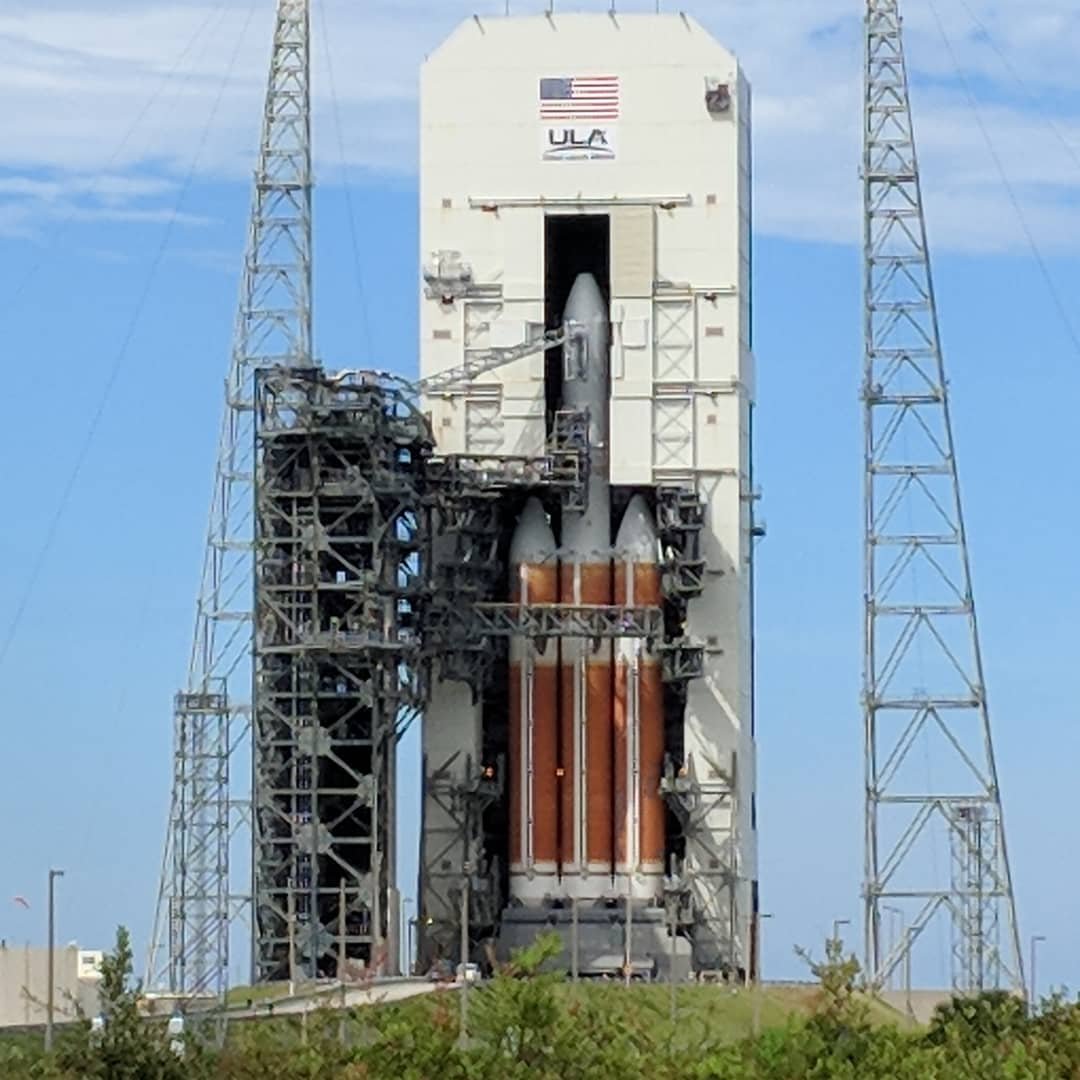2am and the sky looks clear. Who's ready for a rocket launch?
Why is the Parker #SolarProbe launching at night?
Because during the day it would be too hot to visit the sun...
#NASAsocial
Why is the Parker #SolarProbe launching at night?
Because during the day it would be too hot to visit the sun...
#NASAsocial

We've arrived at the causeway and the rocket looks AMAZING lit up across the water. We're about 2.5 miles away.
#NASAsocial #SolarProbe
#NASAsocial #SolarProbe

Make sure you follow #NASAsocial because my fellow attendees have much better night cameras than I do for the Parker #SolarProbe launch.
Tune into NASA tv to watch the launch of the Parker #SolarProbe!
#NASAsocial
nasa.gov/multimedia/nas…
#NASAsocial
nasa.gov/multimedia/nas…
One of the goals of the #SolarProbe is to understand space weather and begin to make predictions the way we predict terrestrial weather.
It will affect astronauts, yes, but also everyone who uses GPS, cell phones, radio, etc...
#NASAsocial
It will affect astronauts, yes, but also everyone who uses GPS, cell phones, radio, etc...
#NASAsocial
Launch is targeted at 3:53 am currently.
This will be the first time I've seen a night launch. When I saw the shuttle launch I was shocked at how *bright* it was.
#NASAsocial #SolarProbe
This will be the first time I've seen a night launch. When I saw the shuttle launch I was shocked at how *bright* it was.
#NASAsocial #SolarProbe
Sensory details from waiting on the causeway. The shafts of light streaming up from the rocket. It's reflection in the water. The smell of bug spray. The growl of waiting buses.
Around me, the low hum of excited voices.
#NASAsocial #SolarProbe
Around me, the low hum of excited voices.
#NASAsocial #SolarProbe
We're listening to the echoing speakers that have NASAtv broadcasting onto the causeway and every time there's an update on the countdown, or the weather, we all pause. Heads tilt toward the speakers, but no one stops watching the rocket.
#NASAsocial #SolarProbe
#NASAsocial #SolarProbe
Above us, the sky is clear & even with the giant work lights, the stars are brighter & clearer than I ever see them in the city. Occasionally, I'll look up to enjoy them, but my eyes keep coming back down to the three Delta heavy rockets under the Parker #SolarProbe
#NASAsocial
#NASAsocial
Whenever someone says it's their first launch to a person who's seen one before, the person they are talking to lights up, knowing the joy in the future.
Then they say, "Watch with your eyes. Not the camera. For the first...be HERE."
#NASAsocial #SolarProbe
Then they say, "Watch with your eyes. Not the camera. For the first...be HERE."
#NASAsocial #SolarProbe
T-minus 10 minutes out from launch!
There will be a hold at t-minus 4, which is standard for every launch for last looks.
#NASAsocial #SolarProbe
There will be a hold at t-minus 4, which is standard for every launch for last looks.
#NASAsocial #SolarProbe
They just did the poll of the launch stations. And good lord, the long pause before Ground said "Go" gave me a little a moment of terror.
Then we got to "No Go conditions BME-7." Folks here groaned.
They are going to report on what that means shortly.
#NASAsocial #SolarProbe
Then we got to "No Go conditions BME-7." Folks here groaned.
They are going to report on what that means shortly.
#NASAsocial #SolarProbe
BME is Booster Main Engine. I'm not sure what 7 is in this context. Anyone from @ulalaunch (who I'm sure are all really tense) able to tell us what area they're concerned about?
#NASAsocial #SolarProbe
#NASAsocial #SolarProbe
35 minutes remaining in the launch window. If they can't resolve the problem within that window, they'll have to scrub.
Given the years of work sitting on the launch pad, and the fact that there is ONE chance to get it right...Err on the side of caution.
#NASAsocial #SolarProbe
Given the years of work sitting on the launch pad, and the fact that there is ONE chance to get it right...Err on the side of caution.
#NASAsocial #SolarProbe
Maybe I should have told them about #marygoround before I applied for #NASAsocial...
Nah. I'm sure there's no correlation between that and the No-Go conditions.
#SolarProbe
Nah. I'm sure there's no correlation between that and the No-Go conditions.
#SolarProbe
They are doing a new poll. They've evaluated the ground data stream and have decided to proceed with the launch!
Go Parker #SolarProbe!
#NASASocial
Go Parker #SolarProbe!
#NASASocial
So, when I say they are doing a poll, what I mean is that each station reports on if their area of responsibility is ready for launch. Each station is supported by a team of people who are evaluating all the information in their area.
#NASAsocial #SolarProbe
#NASAsocial #SolarProbe
They are doing the new poll, which will allow them to exit the t-minus for hold...
Comm hesitated and we all got tense.
"You have permission to launch."
Everyone here cheered!
#NASAsocial #SolarProbe
Comm hesitated and we all got tense.
"You have permission to launch."
Everyone here cheered!
#NASAsocial #SolarProbe
The count has resumed. Just so y'all know I'm going to abandon you for the launch itself and will report back afterwards.
Make sure you are watching NASA tv nasa.gov/nasalive/
#NASASocial #SolarProbe
Make sure you are watching NASA tv nasa.gov/nasalive/
#NASASocial #SolarProbe
We're holding at t-minus 1 minute 55 seconds. We have nine minutes remaining in tonight's window.
Everyone is dead quiet here.
They've reset the clock to 4 minutes and holding.
#NASASocial #SolarProbe
Everyone is dead quiet here.
They've reset the clock to 4 minutes and holding.
#NASASocial #SolarProbe
They are scrubbing and are beginning the power down. So they'll try again in 24 hours.
Excuse me, while I go reschedule my flight...
#NASASocial #SolarProbe
Excuse me, while I go reschedule my flight...
#NASASocial #SolarProbe
@threadreaderapp unroll
• • •
Missing some Tweet in this thread? You can try to
force a refresh














